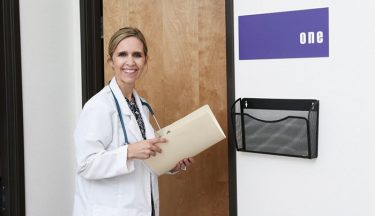By Connie Colbert
GCU Director of Health Services

Back pain is one of the most common health complaints. Some of the interesting statistics about back pain include:
- Approximately 80% of Americans experience a back problem at some point in their lives.
- Low back pain is the single leading cause of disability worldwide.
- 54% of the people with neck or back pain have had these problems for at least five years.
- Around 20% of those experiencing acute lower back pain will end up with chronic pain.
- For every 9 out of 10 patients, the cause of their lower back pain is not clearly known.
- A sedentary lifestyle is the cause of back pain in more than half of the cases.
- 63% of people claim that a new mattress helped them relieve their backaches.
- Lower back pain costs the U.S. more than $100 billion every year, according to chronic low back pain statistics.
- Only about 5% of Americans with back pain need surgery.
- Regardless of treatment, 90% of low back pain issues resolve within six weeks.
Why do we get back pain?
The spine has a hard job! It must support the weight of the upper body and still be able to bend and twist in any direction. This puts great strain on the lower back, particularly among people who do a lot of sitting or who are underactive.
Many conditions may cause back pain. Some are natural occurrences, such as pregnancy and emotional tension. Other factors that can contribute to back problems are physical trauma, athletic injuries, poor physical fitness or being overweight. Some additional examples include:
- Overuse or improper use of the back (poor body mechanics) may cause painful muscle spasms or back strain – i.e., stretching or tearing of muscles.
- Weak abdominal muscles may cause back sprain (i.e., stretched or torn ligaments rather than muscles) because of improper positioning of spine.
- Slipped or ruptured discs may cause pain if discs press upon the spinal nerves. Pain may radiate throughout the legs as well as the back.
- Strain or soft tissue damage, secondary to injury
- Improper posture may cause back strain or sprain because of improper bending, lifting, sitting or standing.
Prevention is important! What can you do?
- Maintain a healthy diet and weight.
- Remain active
- Avoid prolonged inactivity or bed rest.
- Warm up or stretch before exercising or physical activities, such as gardening.
- Maintain proper posture.
- Wear comfortable, low-heeled shoes.
- Sleep on a mattress of medium firmness to minimize any curve in your spine.
- Lift with your knees, keep the object close to your body, and do not twist when lifting.
- Quit smoking. Smoking impairs blood flow, resulting in oxygen and nutrient deprivation to spinal tissues.
- Maintain a computer workstation that is ergonomically correct.
What are some ways I can relieve back pain?
Ice and heat
The application of ice and heat can greatly relieve pain.
- Ice may be applied at any time. Use ice for 10-20 minutes, placing a wet towel between the ice bag and your body.
- Heat is not recommended for the first 48 hours after the onset of back pain. After 48 hours, using heat or ice generally depends on what feels best to you. Use heat for a maximum of 20 minutes at a time.
Keep moving
You may not feel like it, but the best thing to do is keep moving. Try to keep up with your usual level of daily activity and movement. It can be a brisk 30-minute walk or walking your dog. Aim for at least three times a week. If you are sedentary, it allows for the muscles that strengthen your spine to become weak and, in turn, can lead to increased pain.
Nonprescription pain relievers
Nonprescription pain relievers can help with muscle aches and stiffness. The two main types of over-the-counter options are nonsteroidal anti-inflammatory drugs (NSAIDS) and Acetaminophen. NSAIDs include aspirin, Ibuprofen and Naproxen. Always follow manufacturer recommendations for dosing.
Topical creams
Skin creams, salves, ointments or patches may help when your back feels stiff, sore and tense. Many of these products contain ingredients such as menthol, camphor or lidocaine that can cool, heat or numb the affected area. Brand names of such products include Salonpas, IcyHot and Biofreeze.
Stretch and strengthen
Strong muscles, especially in your abdominal core, help support your back. Strength and flexibility may help relieve your pain and prevent it.
Keep good posture
Good posture helps to ease the pressure on your lower back. You can use tape, straps or stretchy bands to help keep your spine in alignment. Aim to keep your head centered over your pelvis. Do not slouch your shoulders or push your chin forward.
If you work in front of a screen, rest your arms evenly on the table or desk and keep your eyes level with the top of the screen. Get up from your chair and stretch and walk regularly.
****
If you are experiencing back pain and would like an expert consultation on treatment, don’t hesitate to reach out to the Canyon Health and Wellness Clinic and schedule an appointment at our Lopes Orthopedic Clinic (phone: 602-639-6215). Or find a local provider to treat the condition.















